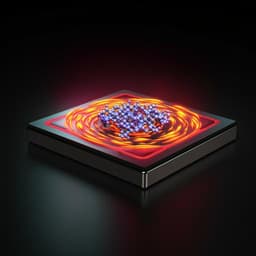
Engineering and Technology
Photon-trapping-enhanced avalanche photodiodes for mid-infrared applications
D. Chen, S. D. March, et al.
Explore the groundbreaking advancements in avalanche photodiodes (APDs) enhanced with photon-trapping structures for mid-infrared applications. This innovative research by Dekang Chen, Stephen D. March, and colleagues tackles the notorious challenge of high dark current in narrow-bandgap materials, leading to significantly improved quantum efficiency and lower dark current density.
Playback language: English
Introduction
Mid-wave infrared (MWIR) photonics, covering the wavelength range of 2–5 µm, is poised to revolutionize various applications, including sensing, spectroscopy, medical diagnostics, and communications. The integration of MWIR devices onto silicon platforms has further expanded their potential. High-performance MWIR photodetectors are crucial components in these photonic systems. A key figure of merit for MWIR photodetectors is the signal-to-noise ratio (SNR). However, achieving high SNR is difficult due to weak signal power in many MWIR applications. Imaging and long-distance sensing often involve weak optical signals, sometimes at the few-photon level. Avalanche photodiodes (APDs) are attractive for MWIR detection because their internal gain amplifies weak signals above noise levels, improving SNR. However, APDs also amplify shot noise, known as excess noise, and in the MWIR range, they suffer from high dark current. Narrow-bandgap materials like HgCdTe, InAs/GaSb type-II superlattices (T2SLs), and InAs/InAsSb type-II strained-layer superlattices (T2SLS) are commonly used for MWIR absorption but exhibit high dark current due to Shockley-Read-Hall generation, tunneling, or thermal generation. Consequently, conventional MWIR photodetectors often require cryogenic cooling to mitigate high dark current. This adds cost and complexity. This research aims to reduce dark current in MWIR APDs without sacrificing quantum efficiency. Reducing absorber thickness directly addresses dark current, but it also reduces photon absorption and quantum efficiency. The solution presented here employs photon-trapping structures to maintain high quantum efficiency even with an ultrathin absorber, improving the SNR. Previous work demonstrated 2 µm separate absorption, charge, and multiplication (SACM) APDs based on AlxIn1-xAs1-ySby, achieving comparable dark current to HgCdTe APDs at a higher operating temperature. This study builds upon that work by incorporating photon-trapping structures, which have not been previously demonstrated in MWIR APDs, to significantly improve the performance.
Literature Review
The literature review highlights the increasing demand for high-performance mid-wave infrared (MWIR) photodetectors driven by advancements in MWIR photonics and its diverse applications. Existing MWIR photodetectors, such as those based on HgCdTe, suffer from high dark current, necessitating cryogenic cooling for optimal operation. The challenges associated with cryogenic cooling, including increased cost and complexity, motivate the search for alternative solutions. The authors cite previous research on AlInAsSb-based SACM APDs, showing promise for low-noise, high-temperature operation at 2 µm. The use of photon-trapping structures, such as photonic crystals and plasmonic structures, has been explored for enhancing light absorption in other photodetectors; however, their application to MWIR APDs remains largely unexplored. The current work addresses this gap by incorporating photon-trapping structures based on submicrometer metal grating arrays, building on previous theoretical simulations suggesting a significant improvement in quantum efficiency.
Methodology
The study designed and fabricated photon-trapping enhanced 2 µm SACM APDs using AlInAsSb material system. The design involves a narrow-bandgap AlInAsSb absorber layer (Eg = 0.58 eV) with a reduced thickness of 200 nm to minimize dark current. This ultrathin absorber is integrated with a wide-bandgap AlInAsSb multiplication layer (Eg = 1.16 eV) known for low dark current, high gain, and low excess noise. A charge layer with an AlInAsSb grading layer ensures efficient electron injection and high bandwidth. To enhance quantum efficiency despite the thin absorber, a two-dimensional rectangular lattice of submicrometer metal grating arrays was incorporated on top of the device. The grating dimensions (spacing, duty cycle, and thickness) were optimized through simulations to achieve maximum light trapping. The device structure was grown by molecular beam epitaxy, and the grating arrays were fabricated using electron beam lithography and lift-off processes. The performance of the fabricated APDs was characterized through various measurements: Current-voltage (I-V) curves were measured at room temperature and at 240 K to determine gain. Excess noise factor was measured to understand noise characteristics. Temperature-dependent dark current density was measured to compare against state-of-the-art HgCdTe and AlInAsSb APDs. External quantum efficiency (EQE) was measured under surface-normal illumination and with varying grating spacings to confirm photon trapping. An alternative edge-coupling approach was also investigated. High-speed performance was assessed by measuring frequency response and extracting bandwidth and gain-bandwidth product. An equivalent circuit model was used to analyze bandwidth limitations. Simulations were performed using Lumerical CHARGE solver to model band structure and electric field profiles. The gain at punch-through voltage was determined by fitting excess noise measurements. Responsivity was measured using a calibrated InGaAs photodiode. EQE for edge-coupled devices was measured using a lensed fiber to couple light into the cleaved edge.
Key Findings
The fabricated photon-trapping enhanced APDs demonstrated significantly improved performance compared to previous state-of-the-art devices. The dark current density was nearly three orders of magnitude lower than that of HgCdTe APDs and nearly two orders of magnitude lower than that of previously reported AlInAsSb APDs at 2 µm. The room temperature dark current density at 180K was 1x10^-6 A cm^-2. The high gain achieved was approximately -700 at 240 K, which is the highest reported for 2 µm APDs using III-V semiconductors. The external quantum efficiency (EQE) reached approximately 22% using the photon-trapping structure and 24% with edge coupling, representing more than three times the efficiency of the bare surface device. The bandwidth reached approximately 7 GHz, and the gain-bandwidth product exceeded 200 GHz – more than four times higher than previous records for 2 µm APDs. The low k-factor of approximately 0.01, comparable to silicon APDs, further contributes to low noise operation. The SNR of the photon-trapping SACM APD was estimated to be ~70 times higher than that of the first 2 µm AlInAsSb SACM APDs and ~20 times higher than that of the state-of-the-art HgCdTe APD under low optical intensity. The EQE measurements with varying grating spacings showed a clear peak at the optimized spacing, confirming the effectiveness of the photon-trapping mechanism. Microwave scattering parameter measurements and equivalent circuit modeling suggest that the conductive GaSb substrate limits the bandwidth and that improved bandwidth could be achieved by using a semi-insulating InP substrate.
Discussion
The results demonstrate a significant breakthrough in MWIR APD technology. The combination of an ultrathin absorber and photon-trapping structures effectively addresses the trade-off between low dark current and high quantum efficiency, resulting in a substantial improvement in SNR. The extremely low dark current achieved allows for operation at higher temperatures, eliminating the need for cryogenic cooling in many applications. The high bandwidth and gain-bandwidth product enhance the high-speed performance of the devices, expanding their suitability for various applications demanding fast signal processing. The low excess noise factor indicates superior noise performance. The success of both the surface-normal photon-trapping and the edge-coupling approaches suggests flexibility in device integration. The findings are consistent with theoretical simulations, supporting the validity of the photon-trapping mechanism. Future research could explore using semi-insulating substrates to improve bandwidth, extending the wavelength range for longer-wavelength APDs.
Conclusion
This research presents a novel design for MWIR SACM APDs that overcomes the limitations of high dark current and low quantum efficiency by employing photon-trapping structures and an ultrathin absorber. The resulting devices exhibit exceptionally low dark current, high gain, high quantum efficiency, and a significantly enhanced bandwidth and gain-bandwidth product compared to existing technologies. The use of photon-trapping represents a significant advancement in MWIR detection and opens up possibilities for new applications. Future studies should investigate utilizing semi-insulating substrates to further improve bandwidth and exploring applications in longer wavelength regimes.
Limitations
One limitation of the study is the difference between the simulated and measured EQE values. This discrepancy is attributed to fabrication limitations such as variations in metal thickness, pattern shape, sidewall bevel angles, and potential oxidation of the Ti adhesion layer. Another limitation is the conductive GaSb substrate which limits the bandwidth, though the study suggests potential improvements by using a semi-insulating InP substrate. The current study focuses on 2 µm operation; further research is needed to extend the findings to other wavelengths in the MWIR range.
Related Publications
Explore these studies to deepen your understanding of the subject.







